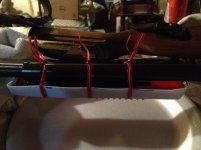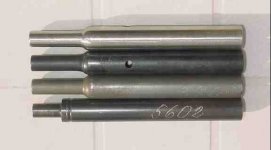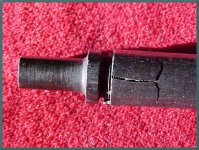robinson479
Well-known member
Hello Kar98k members,
This is my first initial post on the site as I am just getting settled into the forum. First I would like to say I am a young collector who absolutely loves WWII weapons ever since I was a kid growing up. Recently, I purchased a G43 rifle and discovered as I was taking all the parts off, the gas cylinder would not move. YIKES. Did a quick Google search (like we all do) and found a gentlemen with the same problem. I thought cool, this will be fixed in no time. The members of the forum recommended 'Kroil', a penetrating oil to break up the rust and use a little bit of heat on the tube (not too hot). They said to soak the barrel (nose down in a bucket) in the oil for a while, then work it loose. Others recommended PB Blaster, WD-40 and the like.
Link to original post K98k forum: click here and Gunboards post here
Not an issue. I bought some Kroil and made myself a little gadget to soak the cylinder and gas piston in oil for a while since I couldn't figure out a way to soak the entire barrel in it. I started soaking in the middle of April. After looking at the gas cylinder for a while, I noticed a small divot, where it looks like someone tried to punch a hole through it. I quickly thought the divot was adding to the cylinder not being able to move. So, I e-mailed Rob Apfeltor AND Claus Espeholt for their opinions.
Here is what Rob Apfeltor said:
"That divot is where the two pieces of the cylinder are staked together. Definitely NOT the problem. You need real heat my friend, then work it loose." - Rob
And here is what Claus Espeholt said, initially:
"I think the divot is the problem. Can you remove it ? grind it off ? or drill it away ? It's a little pity to do such a thing with an original gas cylinder - but I think you have to do it. Best regards" - Claus
After a few e-mails back and forth, he too came to the same conclusion as Rob after I told him what he said about it. He concluded:
"I think the divot is so close to the “small end” that it can’t be the problem – but I can’t remember I have noticed it before! No I do not think the divot is the problem." - Claus
So, as Rob stated, I used Propane Gas to slightly heat the cylinder and attempt to work the tube loose. No luck. Did a rinse and repeat (soak in Kroil for a few days/week - heat the cylinder with Propane). No luck, yet. I am planning to try and re-heat the cylinder and give it another go tomorrow.
I've attached a few pictures of my Kroil setup that I will explain. I have the receiver and barrel out of the stock, upside down hanging from a piece of rope and sitting on a few wood blocks. I cut a lotion bottle and tied it to the top of the barrel so it would hang and hold the Kroil. I filled the cut lotion tube as much as I could without oil spilling over into the container. Almost the entire cylinder is covered. The barrel is hanging at a slight angle so the oil will run into the gas cylinder and around the gas piston. I have attached the picture of the setup and divot on the pi. It should be noted that when I apply heat to the tube, Kroil starts to come out of the divot, as well as both ends of the tube.
Do you guys have any other suggestions?
This is going to be my thread to track progress or seek help from experts here (if that's OK) until I get this thing off. I'm at the point where I just want the rifle back together and not in pieces! One thing I have to remember is patience is key..
This is my first initial post on the site as I am just getting settled into the forum. First I would like to say I am a young collector who absolutely loves WWII weapons ever since I was a kid growing up. Recently, I purchased a G43 rifle and discovered as I was taking all the parts off, the gas cylinder would not move. YIKES. Did a quick Google search (like we all do) and found a gentlemen with the same problem. I thought cool, this will be fixed in no time. The members of the forum recommended 'Kroil', a penetrating oil to break up the rust and use a little bit of heat on the tube (not too hot). They said to soak the barrel (nose down in a bucket) in the oil for a while, then work it loose. Others recommended PB Blaster, WD-40 and the like.
Link to original post K98k forum: click here and Gunboards post here
Not an issue. I bought some Kroil and made myself a little gadget to soak the cylinder and gas piston in oil for a while since I couldn't figure out a way to soak the entire barrel in it. I started soaking in the middle of April. After looking at the gas cylinder for a while, I noticed a small divot, where it looks like someone tried to punch a hole through it. I quickly thought the divot was adding to the cylinder not being able to move. So, I e-mailed Rob Apfeltor AND Claus Espeholt for their opinions.
Here is what Rob Apfeltor said:
"That divot is where the two pieces of the cylinder are staked together. Definitely NOT the problem. You need real heat my friend, then work it loose." - Rob
And here is what Claus Espeholt said, initially:
"I think the divot is the problem. Can you remove it ? grind it off ? or drill it away ? It's a little pity to do such a thing with an original gas cylinder - but I think you have to do it. Best regards" - Claus
After a few e-mails back and forth, he too came to the same conclusion as Rob after I told him what he said about it. He concluded:
"I think the divot is so close to the “small end” that it can’t be the problem – but I can’t remember I have noticed it before! No I do not think the divot is the problem." - Claus
So, as Rob stated, I used Propane Gas to slightly heat the cylinder and attempt to work the tube loose. No luck. Did a rinse and repeat (soak in Kroil for a few days/week - heat the cylinder with Propane). No luck, yet. I am planning to try and re-heat the cylinder and give it another go tomorrow.
I've attached a few pictures of my Kroil setup that I will explain. I have the receiver and barrel out of the stock, upside down hanging from a piece of rope and sitting on a few wood blocks. I cut a lotion bottle and tied it to the top of the barrel so it would hang and hold the Kroil. I filled the cut lotion tube as much as I could without oil spilling over into the container. Almost the entire cylinder is covered. The barrel is hanging at a slight angle so the oil will run into the gas cylinder and around the gas piston. I have attached the picture of the setup and divot on the pi. It should be noted that when I apply heat to the tube, Kroil starts to come out of the divot, as well as both ends of the tube.
Do you guys have any other suggestions?
This is going to be my thread to track progress or seek help from experts here (if that's OK) until I get this thing off. I'm at the point where I just want the rifle back together and not in pieces! One thing I have to remember is patience is key..








